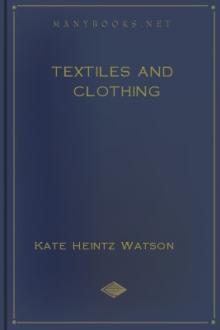Textiles and Clothing, Kate Heintz Watson [best ebook reader for laptop .txt] 📗

- Author: Kate Heintz Watson
- Performer: -
Book online «Textiles and Clothing, Kate Heintz Watson [best ebook reader for laptop .txt] 📗». Author Kate Heintz Watson
Someone has said that "weaving is the climax of textile industry." It is an art practiced by all savage tribes and doubtless was known before the dawn of history. The art is but a development of mat-making and basketry, using threads formed or made by spinning in place of coarser filaments.
In the beginning of the art the warp threads were stretched between convenient objects on the ground or from horizontal supports. At first the woof or filling threads were woven back and forth between the warp threads as in darning. An improvement was the device called the "heald" or "heddle," by means of which alternate warp threads could be drawn away from the others, making an opening through which the filling thread could be passed quickly. One form of the heddle was simply a straight stick having loops of cord or sinew through which certain of the warp threads were run. Another form was a slotted frame having openings or "eyes" in the slats. This was carved from one piece of wood or other material or made from many. Alternate warp threads passed through the eyes and the slots. By raising or lowering the heddle frame, an opening was formed through which the filling thread, wound on a rude shuttle, was thrown. The next movement of the heddle frame crossed the threads over the filling and made a new opening for the return of the shuttle. At first the filling thread was wound on a stick making a primitive bobbin. Later the shuttle to hold the bobbin was devised.
Before the "reed" was invented, the filling threads were drawn evenly into place by means of a rude comb and driven home by sword-shaped piece of wood or "batten." The reed accomplished all this at one time.
It is probable that the European looms were derived from those of India as they seem to be made on the same principle. From crude beginnings, the hand loom of our grandmothers' time developed. A loom has been defined as a mechanism which affects the following necessary movements:
1. The lifting of the healds to form an opening, or shed, or race for the shuttle to pass through.
2. The throwing of the weft or filling by means of a shuttle.
3. The beating up of the weft left in the shed by the shuttle to the cloth already formed. This thread may be adjusted by means of the batten, needle, comb, or any separate device like the reed.
4 & 5. The winding up or taking up of the cloth as it is woven and the letting off of the warp as the cloth is taken up.
No essential changes have been made since our grandmothers made cloth a hundred years ago. The "harnesses" move part of the warp now up, now down, and the shuttle carries the weft from side to side to be driven home by the reeds to the woven cloth. Our grandmothers did all the work with swift movements of hands and feet. The modern weaver has her loom harnessed to the electric dynamo and moves her fingers only to keep the threads in order. If she wishes to weave a pattern in the cloth, no longer does she pick up threads of warp now here, now there, according to the designs. It is all worked out for her on the loom. Each thread with almost human intelligence settles automatically into its appointed place, and the weaver is only a machine tender.
No textiles of primitive people were ever woven in "pieces" or "bolts" of yards and yards in length to be cut into garments. The cloth was made of the size and shape to serve the particular purpose for which it was designed. The mat, robe, or blanket had tribal outlines and proportions and was made according to the materials and the use of common forms that prevailed among the tribes. The designs were always conventional and sometimes monotonous. The decoration never interfered with its use. "The first beauty of the savage woman was uniformity which belonged to the texture and shape of the product." The uniformity in textile, basketry, or pottery, after acquiring a family trait, was never lost sight of. Their designs were suggested by the natural objects with which they were familiar.
FIBERSBoth the animal and vegetable kingdoms furnish the materials for clothing as well as for all the textiles used in the home. The fleece of sheep, the hair of the goat and camel, silk, furs, and skins are the chief animal products. The principal vegetable fibers are cotton, flax, ramie, jute, and hemp.
Cotton linen, wool, and silk have heretofore formed the foundation of all textiles and are the principal fibers used for clothing materials. Ramie or China grass and pineapple fibers are sometimes used as adulterants in the manufacture of silk. When woven alone, they give soft silky textiles of great strength and beauty.
COTTONCotton is now our chief vegetable fiber, the yearly crop being over six billion pounds, of which the United States raises three-fourths. Texas is the largest producer, followed by Georgia, Alabama, and Mississippi. The remainder of the world supply comes chiefly from India, Egypt, Russia, and Brazil. The Hindoos were the first ancient people to make extensive use of the cotton fiber. Not until the invention of the cotton gin by Eli Whitney in 1794 did the cotton begin to reach its present importance. Only four or five pounds of the fiber could be separated by hand from the seed by a week's labor. The modern saw gins turn out over five thousand pounds daily.
Cotton is the white downy covering of the seed of several special of cotton of cotton plant. It is a native of many parts of the world, being found by Columbus growing in the West Indies and on the main land, by Cortez in Mexico, and Pizarro in Peru.
The value of cotton depends upon the strength, and evenness of the fiber. In ordinary cotton the individual fiber is about an inch in length. The sea island cotton grown chiefly on the islands off the coast of Georgia, Carolina, and Florida is the most valuable variety, having a fine fiber, one and one-half to two inches in length. Some of the Egyptian cotton belongs to this species. Sea island cotton is used chiefly for fine laces, thread and knit goods and for the finest lawns and muslins.
The short fiber or upland cotton is the most common and useful variety. It is grown in Georgia, North and South Carolina and Alabama. Texas cotton is similar to upland, but sometimes is harsh with shorter fiber. Gulf cotton occupies a position between upland and sea island cotton.
The Brazilian and Peruvian cotton yields a long staple and is sometimes used to adulterate silk and other fibers. Some varieties of this cotton are harsh and wooly and are prized for use in mixing with wool.
The Nankin cotton grown in China and India and in the southwestern part of Louisiana is characterized by its yellow color. It is used in weaving cloth of various kinds in the "fireside industries" which have become popular in the United States and England.
Very fine yarn can be spun from cotton because of the spiral character of the fibers. This twist of the fibers is peculiar to cotton, being present in no other animal or vegetable fiber. On account of this twist, cotton cloths are much more elastic in character than those woven from linen, the fibers of which are stiff and straight.
After the removal of the seed, no other fiber is so free from impurities—5 per cent is the loss sustained by cleaning and bleaching. In its natural condition, cotton will not dye readily because of a waxy substance on the surface of the fibers. This must be removed by washing.
Cotton should be picked only when it is fully ripe when the pods are fully burst and the fibers expanded. The unripe fiber is glassy, does not attain its full strength and resists the dye. After picking, the cotton is sent to the ginning factory to have the seed removed. It is then pressed into bales by hydraulic presses, five hundred pounds being the standard bale in the United States.
Purified bleached cotton is nearly pure cellulose. It resists the action of alkalis well, but is harmed by hot, strong acids, or if acid is allowed to dry on the fabric. It is not harmed by high temperature, and so may be ironed with a hot iron.





Comments (0)